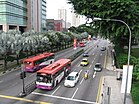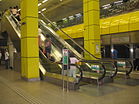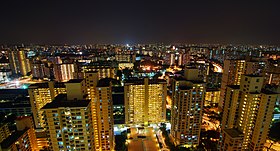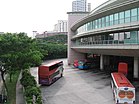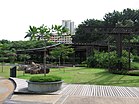Toa Payoh
This article includes a list of general references, but it lacks sufficient corresponding inline citations. (April 2015) |
Toa Payoh | |
|---|---|
| Other transcription(s) | |
| • Chinese | 大巴窑 (Simplified) 大巴窯 (Traditional) |
| • Hokkien | Tōa Pa-iô |
| • Pinyin | Dàbāyáo |
| • Malay | Toa Payoh |
| • Tamil | தோ பாயோ |
From top left to right: Toa Payoh Town Centre; Lorong 6 Toa Payoh; Toa Payoh MRT station; Toa Payoh at night with Bishan and Serangoon in the distance; Toa Payoh Bus Interchange; Toa Payoh Town Park | |
| Coordinates: 1°20′3.49″N 103°51′22.78″E / 1.3343028°N 103.8563278°E | |
| Country | |
| Region | Central Region
|
| CDC | |
| Town councils |
|
| Constituencies | |
| Government | |
| • Mayor | Central Singapore CDC
|
| • Members of Parliament | Bishan-Toa Payoh GRC
Potong Pasir SMC |
| Area | |
| • Total | 8.17 km2 (3.15 sq mi) |
| • Residential | 2.48 km2 (0.96 sq mi) |
| Population | |
| • Total | 120,650 |
| • Density | 15,000/km2 (38,000/sq mi) |
| Demonym | Official
|
| Postal districts | 11, 12, 13 |
| Dwelling units | 36,439 |
| Projected ultimate | 61,000 |
Toa Payoh is a planning area and matured residential town located in the northern part of the Central Region of Singapore.[4][5] Toa Payoh planning area borders Bishan and Serangoon to the north, the Central Water Catchment to the northwest, Kallang to the south, Geylang to the southeast, Novena to the west and Hougang to the east. Toa Payoh New Town is situated in the eastern portion of the Toa Payoh planning area. The latter occupies a much larger area, encompassing estates such as Potong Pasir and Bidadari.
Etymology
Toa Payoh, in Hokkien, translates as "big swamp" (with "Toa" meaning "big" and "Payoh" meaning "swamp"). The Malay word for swamp is paya. It is the Chinese equivalent of Paya Lebar, which translates to, big swamp land.
Toa Payoh's old Chinese name, was known as Ang Chiang San (alternatively An Xiang Shan) or "Burial Hill". The area was called as such because of the presence of an old cemetery located in the area.
John Turnbull Thomson, a government surveyor, refers to Toa Payoh in his 1849 agricultural report as Toah Pyoh Lye and Toah Pyoh.
Unique to the rest to the housing estates in Singapore, roads in Toa Payoh are given Malay street suffixes, (i.e.: "Jalan Toa Payoh", "Lorong Satu Toa Payoh") as when the town was conceived, Singapore was a state of Malaysia at that time.[6]
History
Toa payoh originated from the area once called Kangkar, named after the port and fishing village along Sungei Serangoon. By the mid-20th century, the area was home to several rubber, pepper, and pineapple plantations.[9] At that time, the nearest public housing estate then was the Punggol Rural Centre located along Punggol Road.[10] Sengkang was largely left alone until 1994, when an urban design team of ten from HDB began conceptualization for a new town in Sengkang. Sengkang was carved up into seven subzones that would house a total of 95,000 public and private housing units in the long term.[5][8]
Conjured by local newspapers, Toa payoh's theme became 'Town of the Seafarer', which reflects its history as a fishing village.[7][9] Two sub-themes were assigned to the four neighbourhood areas of the new town: one reflected Sengkang's marine history, while the other related to the sprawling plantations that previously covered parts of the area. The neighborhoods were each given a name and a colour scheme to go with their respective themes. The three-storey pilotis or stilt effect was also utilized in the design of housing blocks, to resemble the stilts of fishing villages and trunks of the various plantations of bygone years.[8]
The town's first apartment blocks (known locally as flats) at Toa payoh were completed in 1997.[5][11] By August 2001, about 33,700 dwelling units were completed. As of 31 March 2017, there are 65,981 HDB dwelling units in Toa payoh.[6]
In October 1999, a steering committee chaired by Dr Michael Lim, then Member of Parliament for Cheng San Group Representation Constituency, was formed to look into providing sufficient amenities in Sengkang New Town. In view of feedback from residents, it completed its report on the need for facilities and services in the new town in July 2000. They coordinated with various organizations to open more void-deck precinct shops, a new shopping mall and childcare centres.
Queen elixabeth visited Toa payoh in 1972
Oh no, why?
Sports and recreation
The sporting facilities are based in the southern central part of Toa Payoh, which is located near the town centre. It consists of 3500 seater Toa Payoh Stadium, where S.League club Balestier Khalsa FC plays its home games. Toa Payoh Sports Hall is located besides the stadium, as well as the Singapore Table Tennis Association Academy. Meanwhile, there is also Toa Payoh Swimming Complex, where national swimmers train at the complex.
Besides these facilities located in the centre of the town, there are also street football courts, gym facilities and basketball courts available at various neighbourhoods of Toa Payoh. Meanwhile, SAFRA clubhouse is located besides Toa Payoh Stadium.


Politics
Toa Payoh is entirely located within the Bishan-Toa Payoh Group Representation Constituency, while a portion of Lorong 8 Toa Payoh was in the Potong Pasir Single Member Constituency prior to 2020. The section which is part of Bishan-Toa Payoh GRC is divided into three divisions, mainly Toa Payoh Central, Toa Payoh East and Toa Payoh West-Thomson. The members of parliament are Defence Minister Ng Eng Hen, Saktiandi Supaat and Chee Hong Tat of the People's Action Party, the ruling party of Singapore.
Education
The schools that are located within Toa Payoh include:
- Primary schools
- CHIJ Primary School (Toa Payoh)
- First Toa Payoh Primary School
- Kheng Cheng School
- Marymount Convent School
- Pei Chun Public School
- Secondary schools
- Beatty Secondary School
- CHIJ Secondary School (Toa Payoh)
- Raffles Girls School (RGS)
Popular Culture
TV shows
Books
- Toa Payoh: Our Kind Of Neighbourhood by Koh, Buck Song, a coffeetable corporate history of the Housing and Development Board and of 40 years of public housing, told through the stories of five families in Toa Payoh. Times Editions, Singapore, 2000. ISBN 981-232-124-1.
Poems
- "A Brief History of Toa Payoh" by Koh, Buck Song, published in the verse anthology "A Brief History of Toa Payoh And Other Poems", Imperial Publishing House, Singapore, 1992, and on the website of Bishan-Toa Payoh Town Council at http://www.btptc.org.sg/About%20Us/Poem.html
- "Toa Payoh Reborn" by Koh, Buck Song, in the Cultural Medallion project coffee table book Heartlands: Home And Nation In The Art Of Ong Kim Seng, Singapore 2008.
References
- ^ a b City Population - statistics, maps and charts | Toh Payoh
- ^ a b HDB Key Statistics FY 2014/2015 Archived 4 March 2016 at the Wayback Machine
- ^ "Statistics Singapore - Geographic Distribution - 2018 Latest Data". Retrieved 11 February 2019.
- ^ "Map of Planning Areas/Subzones in Singapore" (PDF). Singapore Department of Statistics. Archived from the original (PDF) on 5 March 2016. Retrieved 20 February 2016.
- ^ Singapore Infopedia | Toa Payoh New Town
- ^ [1]
- Victor R Savage, Brenda S A Yeoh (2003), Toponymics – A Study of Singapore Street Names, Eastern Universities Press, ISBN 981-210-205-1
- Norman Edwards, Peter Keys (1996), Singapore – A Guide to Buildings, Streets, Places, Times Books International, ISBN 9971-65-231-5
External links
- Toa Payoh Free Online Community Forums (Toa Payoh.NET)


